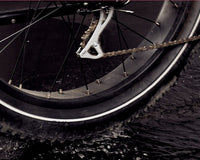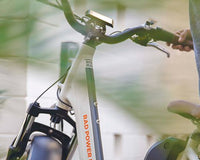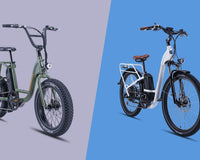The motor, arguably one of the most integral components on any ebike, has seen many variations over the years. A motor needs to be designed correctly in order to propel an electric bicycle efficiently. Similar to a car, an ebike motor can be mounted at the front, middle, or the rear of the bike and is offered in all shapes and sizes. The most popular types of motors found on ebikes are hub and mid-drive motors. Hub motors generally have two variations, a geared hub motor or a direct drive motor. While the above types of motors are by far the most popular, other variations like friction based rear-mounted motors have seen some use over the years.
Each variation of motor comes with its own benefits and potential shortcomings. For example, someone commuting to and from work on relatively flat pavement will find that a direct drive motor may be the most efficient option. However, someone in need of a full suspension electric bike for downhill mountain biking purposes would not be very interested in a direct drive motor.
To better understand each motor variation we will dive into the history of electric bike motors as well as more information pertaining to each style below.
History of Ebike Motors
Bicycles have been around for centuries. It was only a matter of time for humans to invent some sort of system that allowed for electrical assistance when propelling a bike forward. In the late 19th Century, in France, one of the earliest electrical bicycle patents utilized a hand-lever system to propel the bike forward without the use of pedals. Once this first patent was released, minds from all over the world were inspired to invent one of the world’s first electric bikes.
The first known rear mounted hub motor was patented in 1895 by Ogden Bolton Jr. The motor was mounted in the rear wheel of the bike, which is a system that is still very common in today's technology. Ogden designed the patent with a magnetic system in mind and was known as one of the worlds first direct drive motor designs.
In 1897, Hosea W. Libbey patented the first documented mid-mounted motor, similar in some aspects to modern mid-drive motors. For this design, the battery was mounted in the middle of the bike, between the top and bottom tube of the frame, and powered the mid-mounted motor.
Close behind, the first friction drive motor appeared as a patent in 1899 by John Schnepf. The theory there was to create a friction-based system in order to further propel the bike electrically. The set up utilized a roller mounted on the rear tire that gathered energy from the friction produced by the moving wheel. Similar to the previous patented idea, this design is similar to friction drive motors found on some ebikes today!
Geared Hub Motor
Below is a chart describing the pro’s, con’s, and what type of situation a geared hub motor is best for.
|
Pros |
Cons |
Best For |
|
Geared hub motors are generally a durable option |
Slightly less efficient than Direct Drive motors |
Most effective on ebikes in the 250W to 1000W range |
|
A geared hub motor offers a high amount of low-end torque |
Can make removing the rear wheel more difficult than some other motor styles |
Great option for bikes designed for off road purposes or those that need to tackle any type of elevation gain |
|
Motor power does not travel through the bike chain so there is no additional stress or wear the drive train |
||
|
Internal clutch allows the motor to freewheel when traveling at high speeds |

Rad Power Bikes utilizes a geared hub motor on the RadRover, the RadMini, the RadMini Step-Thru, the RadRunner, and the RadRunner Plus. A geared hub motor is a popular option among ebike companies because they are durable, allow for a more affordable bike, and offer a great range of low-end torque. Most ebike companies utilize a geared hub motor, a direct drive motor, or a mid-drive motor. These various motor types each come with their own positive's and negatives and are unique to different rider situations.
A geared hub motor will thrive best for scenarios that call for off-road or bumpy terrain as well as inclines and declines. Similar to a mid-drive motor and as stated above, a geared hub motor offers a good amount of low-end torque. The increase in torque, when compared to a friction drive or direct drive motor, is going to allow the bike to glide uphill or through uneven terrain with ease. A geared hub motor is technically the fastest motor on the market. The internal clutch system disengages the magnets from passing over the stator when going downhill. So, a geared hub motor will offer the fastest downhill free-wheel capability.
While a geared hub motor is a more affordable option when compared to a mid-drive motor, it may not provide as high of a performance rate. Someone in need of the highest end dual suspension ebike should look towards a mid-drive motor. However, if you are in the market for an affordable option that offers a great amount of performance in its own right, a geared hub motor is a good choice!
Direct Drive Motor
Below is a chart describing the pro's, con's, and what type of situation a direct drive motor is best for.
|
Pros |
Cons |
Best For |
|
Has few components making this the most durable option |
Does not offer as much low-end torque when compared to a geared hub or mid drive motor |
Great option for city commuters who have longer distances to cover without many hills or inclines |
|
|
Can make removing the rear wheel more difficult than some other motor styles |
Someone who wants to utilize regenerative braking |
|
This type of motor allows for regenerative braking. |
The bike’s freewheel capability is reduced |
|
|
The most efficient motor in longer, higher-speed trips |
||
|
Is the most quiet type of motor
|

As stated above, a direct drive motor is a popular option amongst ebike companies. Rad Power Bikes utilizes a direct drive motor on our RadWagon, RadCity, and RadCity Step-Thru models. A direct drive motor is normally found near the hub of the rear wheel and utilize a system of magnets to propel the bike. The benefit of the motor being directly connected to the wheel is that it can offer a regenerative braking feature. Regenerative braking is a complex science that requires a more sophisticated software embedded within the controller. The bike’s freewheeling capabilities will be reduced because when the wheel spins, the magnets will be passing windings in the motor always. This creates more resistance in the wheel. The freewheeling capabilities will be further reduced, or rather, further reduced on purpose to ensure high speeds aren't achieved that could create a reverse break down situation within parts of the controller. The controller will have to be more durable with this in mind as well. Although the regenerative braking is a complex system, most kits and all electric bike manufacturers already have the engineering installed. So, the user will never have to worry about figuring this out themselves.
A direct drive is most efficient at top motor speed. However, getting to that speed is less efficient than other motor types. What this means is that for a longer commute with little stops or hills, a direct drive motor is going to be the most efficient option.
Mid Drive Motor
Below is a chart describing the pro’s, con’s, and what type of situation a mid-drive motor is best for.
|
Pros |
Cons |
Best For |
|
Offers a good amount of low-end torque |
Is the most expensive option and the most expensive motor for maintenance costs |
High-performance bikes |
|
Can offer the highest peak performance of any other motor |
The motors power runs through the chain, which puts more stress on the chain than any other motor type |
Full suspension ebikes |
|
The rear wheel does not have the added weight of a motor and is generally easier to remove |
If the chain breaks on a mid-drive motor, the bike is no longer rideable. Hub motors with throttles can still be propelled by the throttle if the chain breaks |
Ebikes with a 250W motor or ebikes in need of 1000W and above |
|
When freewheeling, the bike will actually feel like a normal bike since the chain won’t be moving in a coasting situation |
|
Great option for bikes designed for off-road purposes or those that need to tackle any type of elevation gain |

You may be asking, “If a geared hub motor and a mid-drive motor both offer a similar amount of torque, which option should I choose?” The answer to this question is circumstantial and is based off an array of variables. The biggest hitting points are price and performance. For a mid-drive motor, you get what you pay for. However, it is going to come at a much higher cost than its competitors. Due to this, a mid-drive motor is best utilized on ebikes meant for high-performance situations. On a mid-drive motor, the performance of the bike is heavily based on the rider. This is due to the placement of the motor type, which utilizes the chain and pedals.
I will note that there are a few significant downfalls to a mid-drive motor outside of the high sticker price. The first of which regards the chain. On a mid-drive motor, the motors power runs through the chain. This is unique to a mid-drive motor. Due to this, the chain goes through more stress than any of the other motor types. The added stress can cause the chain to break. If the chain breaks on a mid-drive, the bike is no longer rideable because the bike relies on the chain to move. If a geared hub or direct drive motor breaks the chain, which is less likely because the chain isn’t under the same amount of stress, you can still use the throttle function to ride the bike. The majority of mid-drive ebikes do not even have a throttle function!
Front vs Mid vs Rear Mounted Motor
Electric bike motors can be mounted at the front, middle, or rear of the bike. Each mounting point comes with its own advantages and disadvantages. Below are several charts highlighting the reasoning for and against each mounting placement.
Front Mounted Hub Motor
|
Pros |
Cons |
|
Places less stress on the rear axle which may allow for a solidified mounting point for a bike trailer or tow behind |
Front forks are not typically designed to accommodate the extra stress of a ebike motor |
|
If the chain breaks, you can still use the motor through either the cadence sensor or throttle |
A front mounted motor applies more weight in the front of the bike and makes the bike feel heavier as well as affecting steering |
|
Cannot go over bumps or pop curbs with the added weight of a front mounted motor |
|
|
Makes removing the front wheel more difficult with the added weight and the absence of a quick release; instead utilizes a bolting system |
|
|
Torque arms cannot easily and aesthetically be added to front fork dropouts |
Mid Drive Motor
|
Pros |
Cons |
|
Best weight distribution |
Places more stress on the bike chain |
|
Does not place added stress to the front or rear hub of the bike |
If the chain breaks, you will be stranded |
|
Allows for easy access to both the front and rear wheel |
Increase wear rate of other drive train components such as the front sprocket and rear cassette |
|
Allows for coasting without any motor resistance |
Rear Mounted Hub Motor
|
Pros |
Cons |
|
A rear-mounted hub motor can better handle the extra weight and components of the motor when compared to a front mounted motor |
Use of trailers mounted to the axle potentially compromised due to the presence of motor cable and additional motor mounting hardware |
|
Does not put added stress on the front fork |
|
| If the chain breaks, you can still use the motor through either the cadence sensor or throttle | |
|
Keeps weight low and towards the back of the bike for smooth bike handling
|
It is important to know which type of ebike motor is best for the type of riding you intend to do. Each style of motor, as highlighted above, has its own advantages and potential shortcomings. At Rad Power Bikes, we are proud to use Geared Hub Motors and Direct Drive motors. We utilize two motor variations to accommodate a wide array of potential riders!








